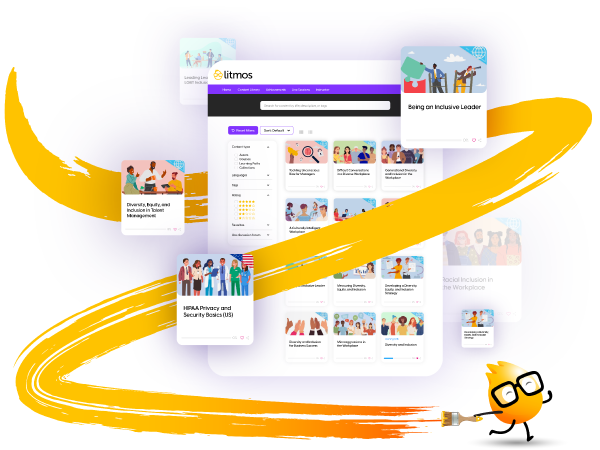The Unique Challenges Facing Mid-Market Companies in 2026 (and How L&D Can Help)
Key Takeaways:
|
Despite economic uncertainty, 72% of companies surveyed as part of the KeyBank Middle Market Sentiment Report maintain an optimistic outlook for the year ahead. This same report shows that companies are choosing to focus on elements within their control, such as improved efficiency and technological improvements.
Economic uncertainty and rapid technological advances present a complex landscape of opportunities and challenges for mid-market businesses. To thrive in this environment, business leaders must align with Learning and Development (L&D) to identify strategic training priorities that drive growth, efficiency, and resilience.
In this article, we’ll explore the top challenges facing mid-market leaders in 2026, and how L&D can provide the training tools and strategies needed to address them.
Top 7 Challenges Facing Mid-Market Businesses in 2026
Challenge #1: Expansion & Market Growth
Mid-market businesses are prioritizing expansion into new domestic and international markets as a key growth strategy in the coming year, as companies look to diversify revenue streams and reduce their exposure to local volatility.
How L&D Can Help:
Learning and Development (L&D) plays a pivotal role in helping mid-size businesses expand and grow into new markets by equipping employees with the skills and knowledge necessary to navigate unfamiliar landscapes. To navigate new markets effectively, your teams need market-specific knowledge and skills such as market analysis, cultural competence, and global business practices. Through tailored training programs, L&D can prepare growing mid-market teams to adapt to the cultural, regulatory, and operational nuances of new regions and their regulations and customer preferences.
Challenge #2: Efficiency Improvements & Cost Reduction
Cost management and operational efficiency are high priorities for mid-market businesses, especially in the face of economic uncertainty. To combat inefficiency and rising costs, companies are choosing to invest in process improvements, automation, and technology upgrades.
How L&D Can Help:
L&D can deliver training modules that focus on process optimization, lean management, and technology adoption. By making these trainings easily accessible within an LMS, companies can ensure that employees have the knowledge and tools they need to stay productive and up to date on your companies systems, processes, and policies
Aside from covering efficiency-related topics in your training content, you can also improve the efficiency of the way you train employees to improve productivity. Learning in the flow of work delivered with AI learning platforms can upskill and re-skill employees rapidly without taking time from their workday. This can improve time-to-productivity, accelerating the speed at which employees acquire and apply their newly learned skills.
Challenge #3: Talent Retention & Workforce Development
This year 52% of mid-market businesses said talent retention was their top concern. And while “The Great Stay” may slow employee turnover in 2026, there’s no guarantee that retention will remain steady. For employees who do stay at your company next year, job satisfaction and productivity may flag. That’s why providing learning and development opportunities should be a top priority for mid-sized companies looking to maintain employee morale and keep external hiring costs low.
How L&D Can Help:
By investing in continuous learning, mid-size businesses can build a more adaptable and resilient workforce, capable of seizing new opportunities and overcoming challenges, thereby facilitating smoother and more successful market entry and expansion.
Continuous learning not only gives employees growth opportunities, it cultivates a pool of skilled and adaptable talent that your company can tap for future leadership opportunities. This strengthens talent succession planning while boosting the confidence and morale of employees looking to advance their careers.
Challenge #4: Innovation & Product/Service Development
Driving innovation through new products and services is essential for staying competitive. Mid-market companies may increase the pace of new product updates or product releases, to differentiate from competitors and meet evolving customer demands.
How L&D Can Help:
Whether you’re releasing a new product or features weekly, monthly, or bi-annually, your company needs to keep every employee informed of the latest updates to your product and processes. Every team in your organization needs to know your product inside and out, and should be given opportunities to acquire new technical skills or knowledge related to your industry.
Providing easy-to-access bite-sized product training is the bare minimum for ensuring product mastery, but to drive a culture of innovation, your company must also make continuous learning a priority. Weave learning and development opportunities into everyday work with on-the-job training opportunities, flexible learning options, and badges that recognize learning accomplishments. These are the building blocks for a culture of learning, giving employees the room they need to experiment, exchange knowledge, and practice new skills without fear. If schedules are tight, asynchronous microlearning and AI chatbots that surface learning in-the-moment can give your employees the answers they need without interrupting the flow of work or escalating questions to a manager. This takes the pressure off of learning a new skill, while allowing employees to apply it the moment it’s needed. By investing in flexible learning platforms like Litmos, you can update existing product, process, and skills training modules easily, without technical support or external content authoring tools.
Challenge #5: Digital Transformation & Advanced Technology Adoption
Streamlining processes, enabling data-driven decision-making, and enhancing customer experience through digital tools is no longer optional for competitive mid-market companies. And as generative AI becomes more commonplace, mid-market business leaders are spending more time then ever trying to plan for AI adoption in the workplace.
How L&D Can Help:
Despite AI adoption being top of mind for many companies, 32% of middle-market business owners say the biggest barrier to AI adoption is employee understanding. Creating new AI policies and adopting new AI tools across your business won’t have the impact you want if your employees aren’t empowered to use AI safely and efficiently.
By investing strategically in technology training initiatives, your company can stay agile, adaptable, and ahead of the curve. Working with L&D and using AI-powered learning tools can help your organization continuously assess and optimize your skills training programs for relevance and business impact. Making microlearning modules and job aids available through your LMS can provide employees with concise, relevant, and frequent updates on new tools and technologies, the moment those updates are needed. Using reporting and learning analytics can help L&D demonstrate the real-time impact of training across the organization. Cross-functional collaboration can also ensure that every stakeholder understands and has a say in how your company’s employees adopt new technologies.
Challenge #6: Improving Customer Experience
Improving customer experience (CX) drives loyalty and growth. That’s why so many businesses focus on delivering personalized customer experiences and seamless omnichannel engagement. This level of personalization can be especially challenging as customer expectations rise and customer issues become increasingly complex. For customer support teams — especially those working in a remote-first or globally dispersed environment — access to the latest product information, company policies, and customer service skill trainings is a must.
How L&D Can Help:
Staying connected to the latest product updates, company policies, and customer service best practices is foundational to CX success. Training programs that focus on customer service skills, empathy, and understanding customer needs can significantly improve customer satisfaction. Bespoke or out-of-the box training in your company’s CRMs and business systems can help customer service teams get the most out of their tech stack, improving their technological skills while driving productivity. By strategically delivering CX training in the flow of work and making asynchronous training courses available on-demand, your business can keep customer-facing teams educated without adding too much to their plates.
Challenge #7: Risk Management & Business Resilience
As businesses face increasing uncertainty, risk management strategies have become a priority. In the face of inflation, cyber threats, and supply chain volatility, companies are focused on strategies that will help them stay ahead of regulatory shifts, assess risk, and manage crises.
How L&D Can Help:
Compliance training is crucial for ensuring that organizations adhere to legal, regulatory, and ethical standards, helping them mitigate risks, avoid penalties, and maintain a trustworthy reputation. Litmos compliance learning management system (LMS), streamlines and centralizes the management of compliance training, offering a large library of pre-built region and industry specific compliance courses, as well as an easy-to-use content authoring tool that can be used to build customized compliance training courses from scratch. Using robust learning analytics tools, managers can track the compliance training progress of their teams to ensure that everyone completes the necessary training on time and meets latest compliance requirements.
Unlocking Mid-Market Training Potential
By addressing these seven key priorities, mid-market businesses can position themselves for success in 2026 and beyond. Training and development play a crucial role in this process, enabling businesses to build the skills and capabilities needed to drive growth, innovation, and resilience.
Ready to meet these mid-market L&D challenges head on? Download our free L&D Blueprint Guide to unlock practical insights, proven frameworks, and actionable steps to create a future-ready, engaging mid-market training program. Don’t miss your chance to empower your teams and drive sustainable growth—get your “Creating a Learning Blueprint” guide today!




